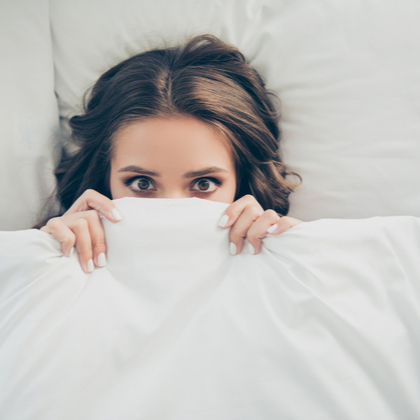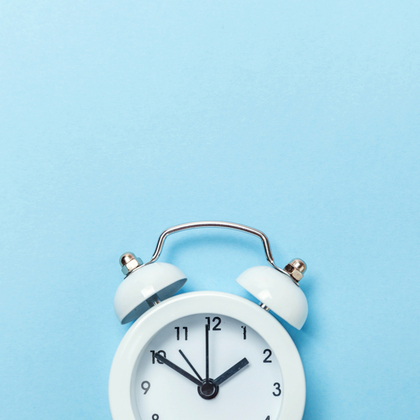
With bitter temperatures, shorter daylight hours, and bouts of flu, many people struggle during the colder months. However, there’s a difference between mere ‘winter blues’ and the medically recognised Seasonal Affective Disorder (SAD). In this article, we explore how SAD influences sleep and discuss the best strategies to manage it.
What is SAD?
Characterised by persistent low mood, a loss of pleasure in everyday activities, irritability, lethargy, decreased libido, feelings of despair, and sleep disruptions, SAD is a type of cyclical depression that occurs between autumn and spring.
Although the exact cause of SAD remains unknown, most experts believe the condition is related to changes in sunlight exposure, affecting the body’s 24-hour internal clock and neurotransmitter levels (1).
Why is light important for our body clock?
Light is critical for the regulation of our body clock, also known as circadian rhythm. When light hits receptors in the eyes, signals are sent to the master clock in the brain, which oversees various bodily functions, including appetite, sex drive, mood, temperature, activity, and, crucially, sleep.
In the absence of adequate light, these functions may veer off their natural course, with sleep being particularly vulnerable to disturbances.
How does SAD affect sleep?
Symptoms of SAD can vary from person to person. Here are some of the ways it can affect sleep.
SAD and circadian rhythm disruption
Our internal body clock is programmed to wake up with sunlight and sleep when it’s dark. Reduced exposure to natural light in the winter months can disrupt the circadian rhythm, leading to irregular waking hours and difficulties falling asleep at the desired time.
SAD and hypersomnia
One distinctive feature of SAD is hypersomnia – excessive daytime sleepiness. Those with SAD may sleep longer than usual, struggle to rise in the morning, and feel exhausted during the day.
SAD and insomnia
Though hypersomnia is more characteristic of winter-onset SAD, some people experience insomnia – difficulty falling or staying asleep. Sleep disturbances can exacerbate lethargy and make it harder to manage low mood and depressive symptoms.
SAD and melatonin production
The brain produces melatonin, the hormone responsible for inducing sleep, in response to darkness. Serotonin, on the other hand, is influenced by sunlight and regulates mood, appetite, and sleep.
Individuals with SAD tend to produce higher levels of melatonin earlier in the day and lower levels of serotonin. This imbalance may contribute to disruptions in sleep patterns and compromise overall sleep quality.
You can learn more about the role melatonin and serotonin play in sleep here.
SAD and mood
Sleep and mood often have a bidirectional relationship, especially in the context of SAD. Poor sleep quality can intensify or lead to feelings of depression and anxiety, which are common symptoms of SAD. Equally, the grip of depression and anxiety can contribute to or initiate sleep issues, perpetuating a vicious cycle.
What is the best way to deal with SAD?
Navigating winter-onset SAD can be extremely challenging. Thankfully, there are some simple ways to support your sleep hygiene and wellbeing.
Try light therapy
Light therapy (phototherapy) is a common and effective treatment for SAD. It involves exposure to a bright light (SAD lamps) that imitates natural sunlight, which can help regulate the body's circadian rhythm and improve mood.
Consider dawn stimulation lights
Dawn stimulation lights are akin to SAD lamps; however, they’re designed to mimic the sunrise and wake you up gently in the morning. For instance, a ‘sunrise alarm clock’ gradually gets brighter over 30 to 90 minutes – similar to the sun in the morning – meaning your room will be illuminated when you wake up.
Let light in
Exposing yourself to as much natural sunlight during the day will help regulate your circadian rhythm. Make an effort to keep your blinds open when the sun’s out, ensure windows are free from objects that might otherwise obstruct natural light, and try to spend plenty of time outside, especially in the morning.
Exercise regularly (and outside!)
Regular exercise releases feel-good endorphins, powerful neurochemicals that support emotional health and help reduce SAD symptoms.
While all physical activity is great, exercising outside has the added benefit of enabling you to bask in natural sunlight, which calibrates your internal clock and connects you with nature, which can lift your mood.
Follow the same sleep-wake cycle
As tempting as it is to crawl back under the covers when you’re alarm goes off during the winter months, try to stick to the same sleep-wake cycle every day, even on weekends. Establishing and following a healthy routine will support your natural circadian rhythm during the winter months.
Vitamin D3 for SAD
Vitamin D3 is synthesised when sunlight hits the skin. But with more overcast days and less natural light, this can be harder in the winter months.
Vitamin D3 is involved in bone, teeth, muscle, and immune health. However, many experts now believe low levels may play a role in worsening mental health outcomes, with studies suggesting a potential link between SAD and low vitamin D3 (2).
Unfortunately, few foods are naturally rich in vitamin D3. You can find some vitamin D3 in oily fish, animal fats, and vitamin D-fortified food products. If you’re vegan or vegetarian, chances are, you’re not getting enough.
To address any possible deficiencies during the darker months, the NHS recommends taking 10 mcg of vitamin D3 every day between October and March.
Add more magnesium
Magnesium is involved in over 300 biochemical processes. It plays a critical role in psychological and nervous system function, which is why it’s often recommended for mood regulation and sleep.
Whole grains, dark chocolate, nuts, and seeds are rich sources of magnesium. You can also take a high-strength magnesium supplement to support your intake.
Speak to your GP
If you need additional help, always reach out to a healthcare professional, together you can formulate a treatment plan.
To find out more about mental wellbeing click here.
Find out more
If you found this piece on SAD and sleep useful, you can delve deeper into similar insights on our dedicated Sleep Health Hub. Alternatively, please get in touch with our team of expert Nutrition Advisors, who are on hand to provide free, confidential advice via email, phone, and Live Chat.*
*Subject to cookie consent
References:
-
Overview - Seasonal affective disorder (SAD). NHS (2021). [online] nhs.uk. Available at: https://www.nhs.uk/mental-health/conditions/seasonal-affective-disorder-sad/overview/.
-
Vitamin D and Depression: The Evidence from an Indirect Clue to Treatment Strategy. Wong SK, Chin KY, Ima-Nirwana S. (2018) Curr Drug Targets. 19(8):888-897.
Related Posts

Do I Have Symptoms Of Insomnia Or Just Trouble Sleeping?

Insomnia Treatments: Natural Remedies To Help You Fall Asleep

Why Am I Always Tired? Signs Of Poor Sleep Hygiene Explained

Olivia
Olivia Salter has always been an avid health nut. After graduating from the University of Bristol, she began working for a nutritional consultancy where she discovered her passion for all things wellness-related. There, she executed much of the company’s content marketing strategy and found her niche in health writing, publishing articles in Women’s Health, Mind Body Green, Thrive and Psychologies.
View More
